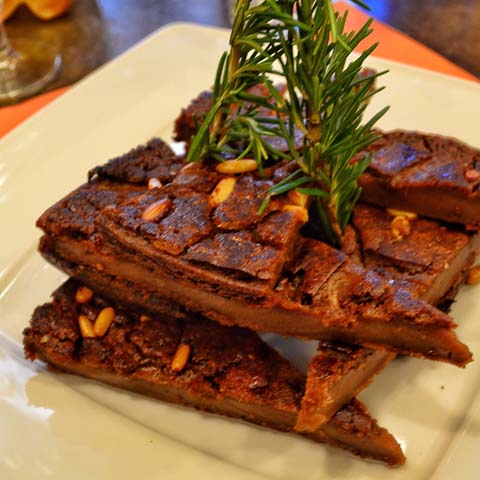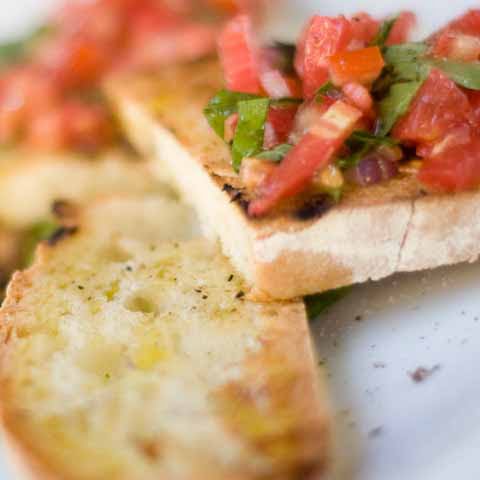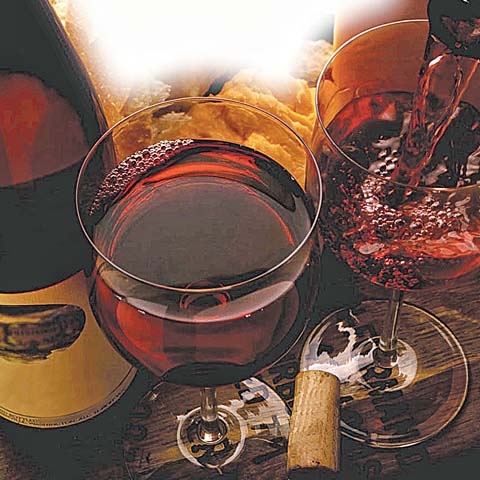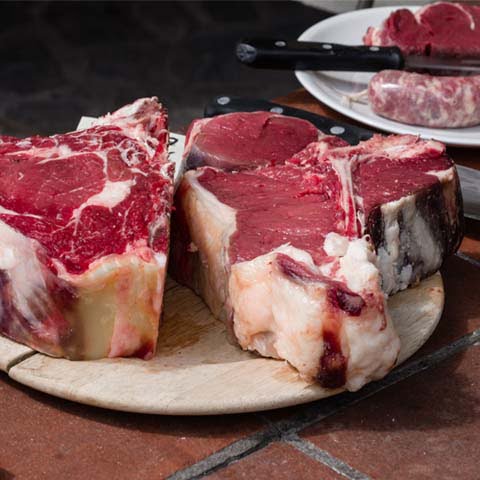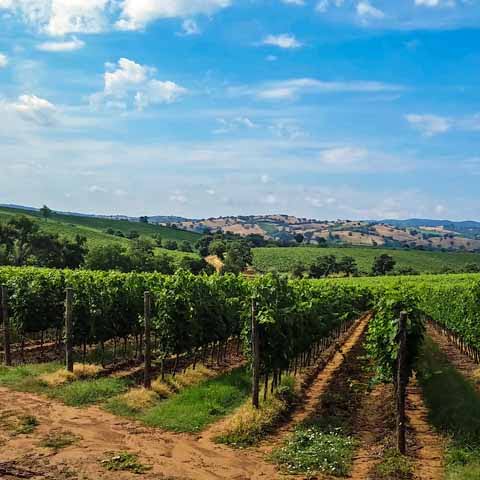Pisa’s cuisine is delicious and varied, much like the landscape of the area that surrounds it. The varietal geography – ranging from hills to farmland to sea – offers local chefs fresh ingredients including seafood, grains, olives, grapes, and more.
Menus throughout Pisa shift and change based on the availability of local ingredients and take their influence mostly from Tuscan cuisine. From prioritizing simple, yet fresh local produce, grain, and meat to widespread use of bread and olive oil, nearly every aspect of a recipe in Pisa is reflective of Tuscan traditions. However, one of the main factors that differentiates Pisan cuisine from general Tuscan food is the vast use of seafood due to Pisa’s proximity to the coast.
Meat dishes throughout Pisa vary from wild game to beef. Mucco Pisano – a special breed of cow only bred in the Pisa countryside – is a key ingredient throughout the city. From tortelli di Mucco (ravioli-shaped pasta filled with Pisan beef and topped with ragù) to second course dishes such as roasts, it is used in nearly every course.
Another important ingredient in Pisa’s cuisine are mushrooms. Often eaten freshly sliced and dressed in salads or used in complex sauces, mushrooms add an earthy and meaty taste to dishes.
Restaurants throughout Pisa, such as those in the historic center, often feature traditional local dishes as well as fine, protected products, including Monte Pisano olive oil, pecorino pisano cheese, Parco di Migliarino lamb, San Miniato truffles, San Rossore pine nuts and Pisanello tomatoes.
Truly, Pisa’s fresh and local cuisine featuring a nice variety of meat and seafood offers the best of both worlds.
APPETIZER
To begin a meal in Pisa, locals utilize Tuscan bread – known for being made without salt – as an appetizer on its own or as the base for a variety of finger foods with vegetables, meat, or seafood.
A common Tuscan appetizer one will find in Pisa is an assortment of crostini, cured meats, and local cheese. As in the rest of Tuscany, one popular type of crostino in the area is made with liver pâté. A common seafood appetizer that may accompany crositini is known as chioccioline di mare, which features sea snails braised in tomato sauce.
This delightful introduction to the world of Pisa cuisine is perfect to warm up the palate for the rest of the meal.
FIRST COURSE
After warming up with appetizers, the first course in Pisa reflects the area’s tradition of “peasant cuisine,” characterized as dishes made from historic recipes using simple and inexpensive ingredients. An example of this type of cuisine is pappa al pomodoro, a recipe invented to utilize stale bread so as not to waste anything. This flavorful soup is prepared by cooking together stale Tuscan bread, tomato sauce, basil, garlic, onions, and extra virgin olive oil.
A popular winter dish, bordatino alla pisana, appears in the first course. This dish is made of a dense broth, beans, Lacinato kale, cornmeal, and a form of fat – either pancetta or lard. Vegetarian versions of this dish exist as well that do not include animal fat. Interestingly, the dish’s name derives from the fact that it was often cooked on board boats carrying corn, which is likely the reason why one of the soup’s main ingredients is cornmeal.
Another traditional dish that features cornmeal is known as palette. A local take on polenta, the dish features polenta served with alternating layers of pork and beef ragù, rabbit giblets, and a mushroom sauce.
Other traditional first course dishes include trenette alla renaiola – an old recipe consisting of long pasta that is narrow and flat served with anchovies and broccoli rabe once prepared by those who would sail along the Arno – and spaghetti con le arselle – a Tuscan coastal recipe made simply with spaghetti, clams, olive oil, parsley, garlic, and cherry tomatoes. The latter dish could also be made with rice or another pasta shape in place of the spaghetti. Bavette sul pesce, consisting of long and narrow pasta served with medium-sized pieces of local fish, is another popular seafood pasta dish in Pisa. Pasta e ceci, a dish made with pasta and chickpeas, is a traditional Tuscan dish, and in Pisa it may be served on its own or with the addition of chard or shrimp.
In addition to pappa al pomodoro and bordatino alla pisana, locals enjoy several other soups as well. Like pappa al pomodoro, ribollita features stale bread. The other main ingredients are cabbage, Lacinato kale, beans, tomatoes, potatoes, and extra virgin olive oil. The soup’s name, which means re-boiled, refers to the fact that each time this soup is heated up it becomes more and more flavorful. Similarly, another soup called zuppa pisana is also made with stale bread in addition to Lacinato kale, pork rind, onions, potatoes, celery, tomatoes, beans, and extra virgin olive oil.
SECOND COURSE
As with the rest of Italy, Pisa’s second course is where one will find the most meat. Dishes like fagioli all’uccelletto are found all over the area. This classic Tuscan recipe combines beans with tomato sauce, garlic, sage, and extra virgin olive oil. In some parts of Italy, sausage may be added to the dish, though in Pisa fagioli all’uccelletto is served with ossobuco (veal shanks).
Pisa’s main local meat is known as mucco pisano. This breed of cattle is said to descend from brown alpine cows and local bulls from the San Rossore Natural Park. The meat is considered to be of very high quality thanks to specific nutrition and rearing methods. Mucco pisano is commonly prepared as a steak, traditionally served rare. The steak may also be sliced and served with vegetables and balsamic vinegar, a preparation known as tagliata di mucco pisano.
Offal or organ meats are common staples of the local cuisine, with a popular dish being trippa alla pisana. The key ingredients include veal tripe, tomatoes, onions, celery, carrots, garlic, and pancetta, which are sauteed together in olive oil. The dish is traditionally served with a sprinkling of Parmigiano-Reggiano cheese.
In addition to trippa alla pisana, locals also enjoy fegatelli di maiale, usually in the winter. To make the dish, ground pork liver and other organ meats are wrapped in caul fat and cooked in lard. This recipe is usually accompanied by a side dish of broccoli rabe or chard.
Wild game is often enjoyed throughout the city of Pisa. The most popular varieties include pheasant, hare, wild boar, and fallow deer. The game is usually slowly braised with herbs and vegetables. Common pairings in Pisa include pheasant with olives as well as wild boar with polenta.
In terms of seafood, popular dishes include anguille in ginocchioni – a unique dish of fried eels cooked in tomato sauce – and muscoli ripieni. Nearly every region or seaside town throughout Southern Italy has their own version of muscoli ripieni. The Pisa version is made with mussels that have been stuffed with ground pork, stale bread that has been soaked in milk or water, pecorino pisano cheese, and spices like nutmeg, garlic, parsley, and olive oil.
Salt cod and stockfish are both common throughout Italy and the local Pisans have a particular way of preparing these fish. In Pisa, baccalà coi porri consists of grilled salt cod served with leeks, tomatoes, potatoes, or chickpeas, while stoccafisso alla pisana features stockfish and boiled potatoes.
Cuttlefish is common in Pisa as well and is the key ingredient in seppie con la bietola. In order to prepare this dish, the cuttlefish is sliced into thin strips and braised with chard or peas.
Other popular seafood dishes include grilled mullet from the Arno River and poached branzino. Older generations of Pisans have fond memories of ce’e alla pisana (juvenile eels sauteed in olive oil with sage and garlic then cooked in a tomato sauce), though today this dish cannot be prepared as it is illegal to fish for juvenile eels.
SIDES & CONDIMENTS
To go alongside nearly any meal, look out for these popular Pisa sides and condiments. One key ingredient enjoyed with bread during meals is a particular type of olive oil called Olio di Oliva dei Monti Pisani. Made from a specific kind of olive tree, this oil is untreated and best enjoyed on its own.
A unique vegetable often common on the tables in Pisa is cavolo nero – Lacinato kale. Often found in various dishes such as soups, pasta, and ravioli, it can be simply sauteed and served as a side dish as well.
STREET FOOD
Nearly every region and city of Italy has a trademark street food, perfect for eating on the go while sightseeing or while relaxing on a bench watching the people go by. In Pisa, that food is called cecina. Made simply with chickpea flour, olive oil, and salt, cecina is a flatbread that is best eaten warm.
DESSERT
To top off an amazing meal in Pisa, there is nothing like dessert. First timers must start out with the most classic dessert of the area – torta co’bischeri. This tart has a unique filling that features chocolate, rice, raisins, and pine nuts. The dessert may be topped with powdered sugar and additional pine nuts. The crust consists of dough formed into points, which are called bischeri by the locals.
Other desserts to try in Pisa are castagnaccio – a chestnut flour cake with raisins, nuts, pine nuts, and rosemary – and Mattonella di Pinoli di San Rossore – a semifreddo made with cream, custard, and toasted pine nuts.
Cantuccini col vin santo, an iconic Tuscan dessert consisting of twice-baked cookies featuring almonds and pine nuts served with sweet Vin Santo wine, can be enjoyed in Pisa as well.
WINE
Among Pisa’s many delicious offerings, we cannot forget to mention the vast wines the province is known for. While the vineyards of the area are not sprawling like other parts of Tuscany, the wines they produce are hailed for their variety and quality, since growers must be selective in their more limited vineyard space.
The wines produced in Pisa are DOC and IGT, meaning they are guaranteed to be produced from specific areas. Some of the best local wines include the Chianti Colline Pisane – a red wine produced along hills that are closer to the sea compared to other Chianti wines – Montescudaio, Bianco Pisano di San Torpé, and Colli dell’Etruria Centrale.
Due to Pisa’s position near the sea, visitors to the city can enjoy popular Tuscan dishes alongside seafood specialties. The varied cuisine showcases the area’s best local ingredients, offering an unforgettable taste of Tuscany.
Don't just see Italy, live it.
Your dream trip to Italy has never been closer
No more endlessly scrolling travel sites. Our travel experts will craft the perfect, one-of-a-kind trip just for you.

300+
DESTINATIONS
We offer more Italian destinations than any travel site. Do and see more with Trips 2 Italy.
1 (of a kind)
ITINERARIES
Because your dream trip to Italy should be designed for you, not for the masses.
100%
PEACE OF MIND
From flights and accommodations, to food and activities - we take care of every detail.
